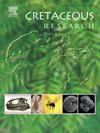The potential of fossil primary feather in taxonomic and ecological prediction
IF 1.7
3区 地球科学
Q1 GEOLOGY
引用次数: 0
Abstract
Feathers, shaped by the interplay of phylogenetic factors and environmental behaviors, serve not only as critical indicators for avian classification but also as carriers of information regarding flight patterns and ecological habitats. Although isolated fossil feathers are frequently undervalued due to the lack of direct skeletal associations, their well-preserved outline and microstructure can provide critical insights into key issues such as feather evolution, the origin of flight behavior, and taxonomic diversity. In this study, we discovered an exceptionally well-preserved distal primary feather from the Lower Cretaceous in the Jiuquan Basin of northwest China. We extracted the morphological outlines of modern primary feathers for elliptic Fourier analysis and combined microstructural data to test whether feather morphology can be used to distinguish taxonomic groups, orders, and habitats. The results indicate that the flight feather morphology in modern birds is predominantly shaped by flight-related adaptations, with significant morphospace differentiation across flight types and taxonomic orders, while habitat exerts minimal influence on feather architecture. Furthermore, multivariate statistical analyses that incorporate fossil data into modern datasets suggest that the primary feather fossil occupies a morphospace position associated with terrestrial ecological and flight mode similar to that of modern passerine type, indicating a potential association between the fossil feather and enantiornithines. However, accurate identification of fossil feather information requires expanded fossil data collection to uncover further insights embedded within the fossilized feathers.
原始羽毛化石在分类学和生态学预测中的潜力
羽毛是由系统发育因素和环境行为共同作用形成的,不仅是鸟类分类的重要指标,而且是鸟类飞行模式和生态栖息地信息的载体。尽管由于缺乏直接的骨骼关联,孤立的羽毛化石经常被低估,但它们保存完好的轮廓和微观结构可以为羽毛进化、飞行行为的起源和分类多样性等关键问题提供重要的见解。在这项研究中,我们在中国西北部的酒泉盆地发现了一根保存异常完好的下白垩统远端原生羽毛。我们提取了现代初生羽毛的形态轮廓进行椭圆傅里叶分析,并结合微观结构数据来测试羽毛形态是否可以用于区分分类类群、目和栖息地。结果表明,现代鸟类的飞行羽毛形态主要受飞行相关适应的影响,在不同的飞行类型和分类目之间存在显著的形态空间差异,而栖息地对羽毛结构的影响很小。此外,将化石数据纳入现代数据集的多元统计分析表明,原始羽毛化石在陆地生态和飞行模式方面占据的形态空间位置与现代雀鸟类型相似,表明化石羽毛与对鸟目之间存在潜在的联系。然而,准确识别化石羽毛信息需要扩大化石数据收集,以揭示化石羽毛中更深层次的见解。
本文章由计算机程序翻译,如有差异,请以英文原文为准。
求助全文
约1分钟内获得全文
求助全文
来源期刊

Cretaceous Research
地学-地质学
CiteScore
4.10
自引率
19.00%
发文量
235
审稿时长
12 weeks
期刊介绍:
Cretaceous Research provides a forum for the rapid publication of research on all aspects of the Cretaceous Period, including its boundaries with the Jurassic and Palaeogene. Authoritative papers reporting detailed investigations of Cretaceous stratigraphy and palaeontology, studies of regional geology, and reviews of recently published books are complemented by short communications of significant new findings.
Papers submitted to Cretaceous Research should place the research in a broad context, with emphasis placed towards our better understanding of the Cretaceous, that are therefore of interest to the diverse, international readership of the journal. Full length papers that focus solely on a local theme or area will not be accepted for publication; authors of short communications are encouraged to discuss how their findings are of relevance to the Cretaceous on a broad scale.
Research Areas include:
• Regional geology
• Stratigraphy and palaeontology
• Palaeobiology
• Palaeobiogeography
• Palaeoceanography
• Palaeoclimatology
• Evolutionary Palaeoecology
• Geochronology
• Global events.
 求助内容:
求助内容: 应助结果提醒方式:
应助结果提醒方式:


